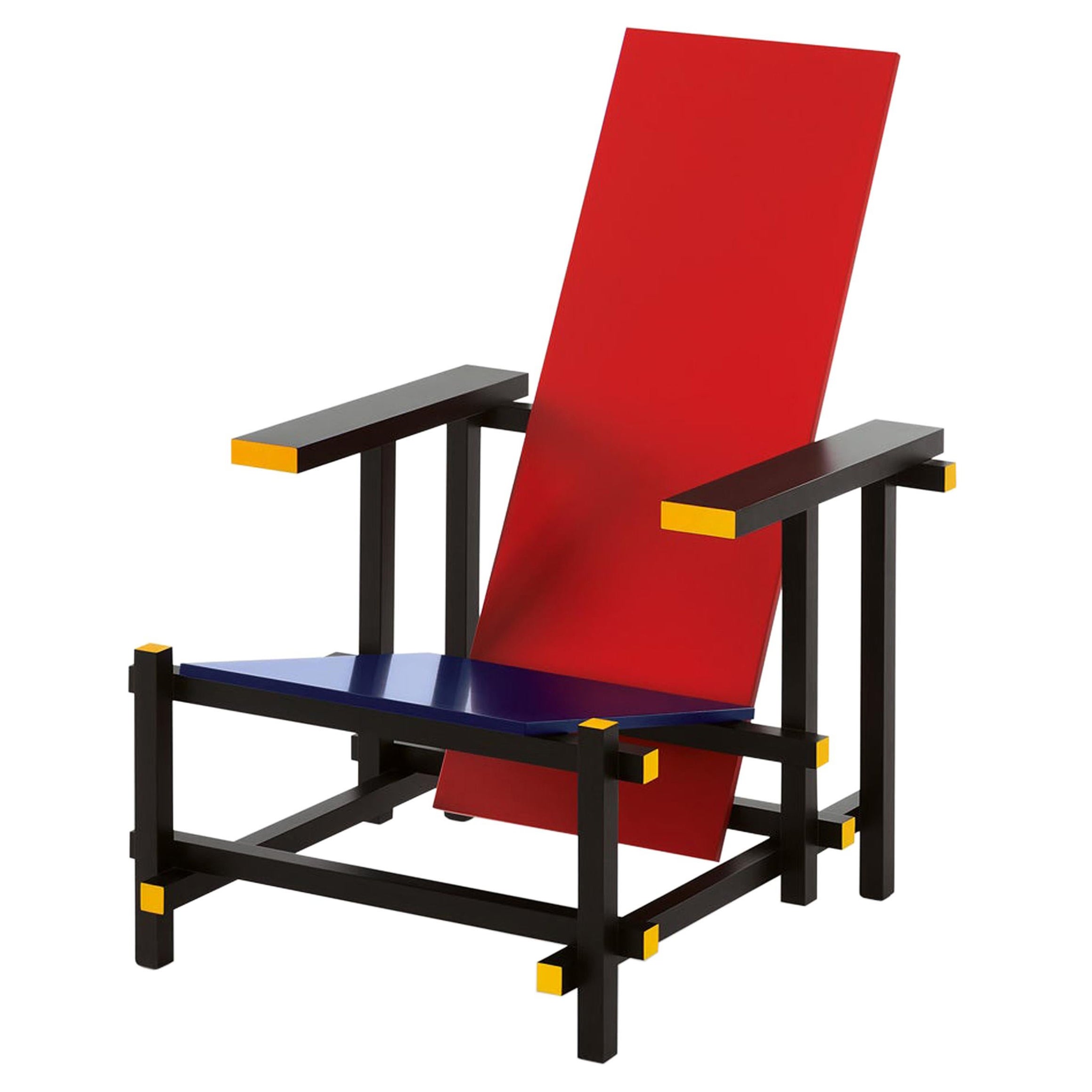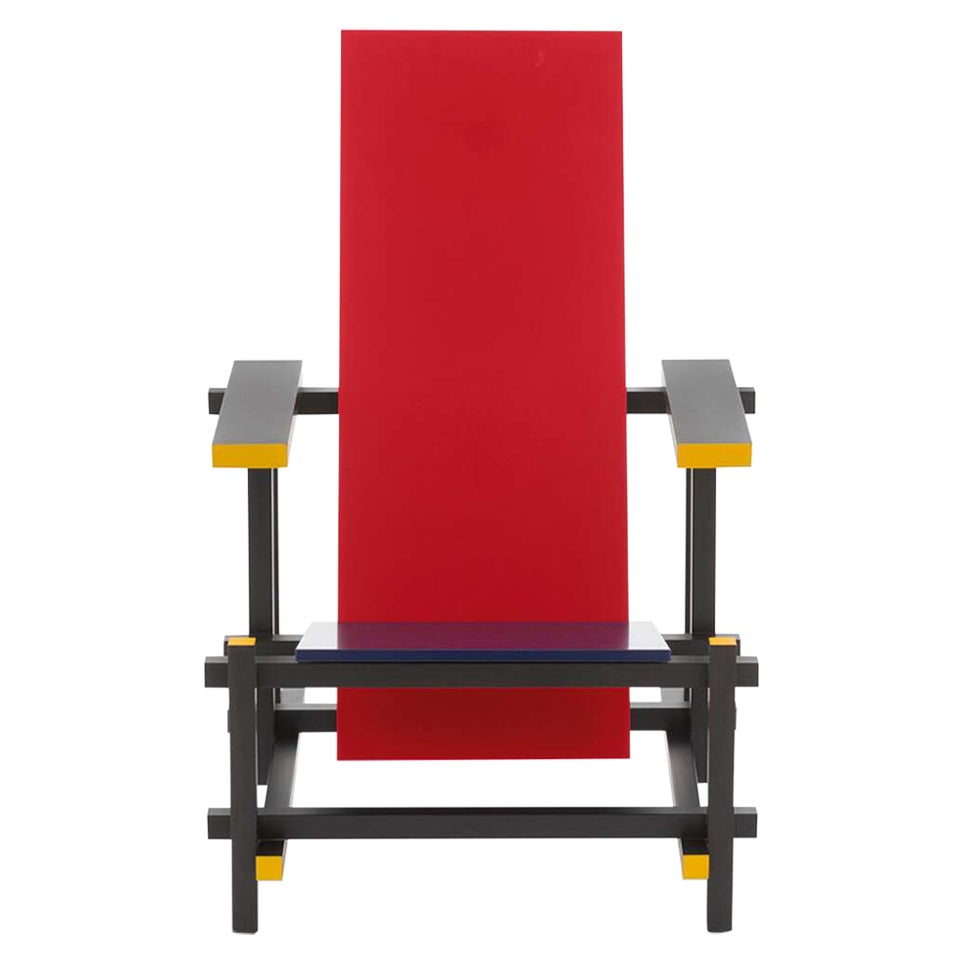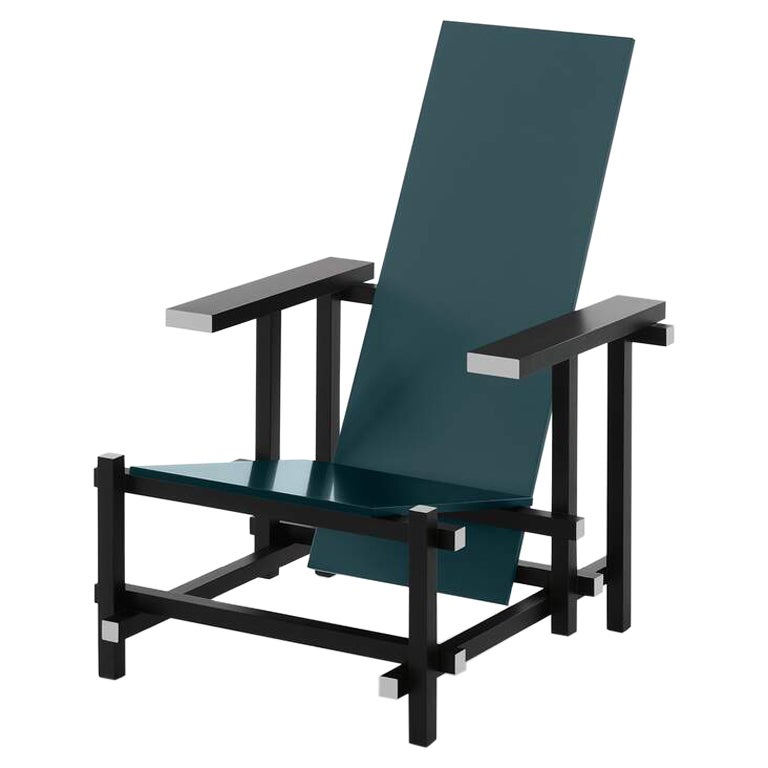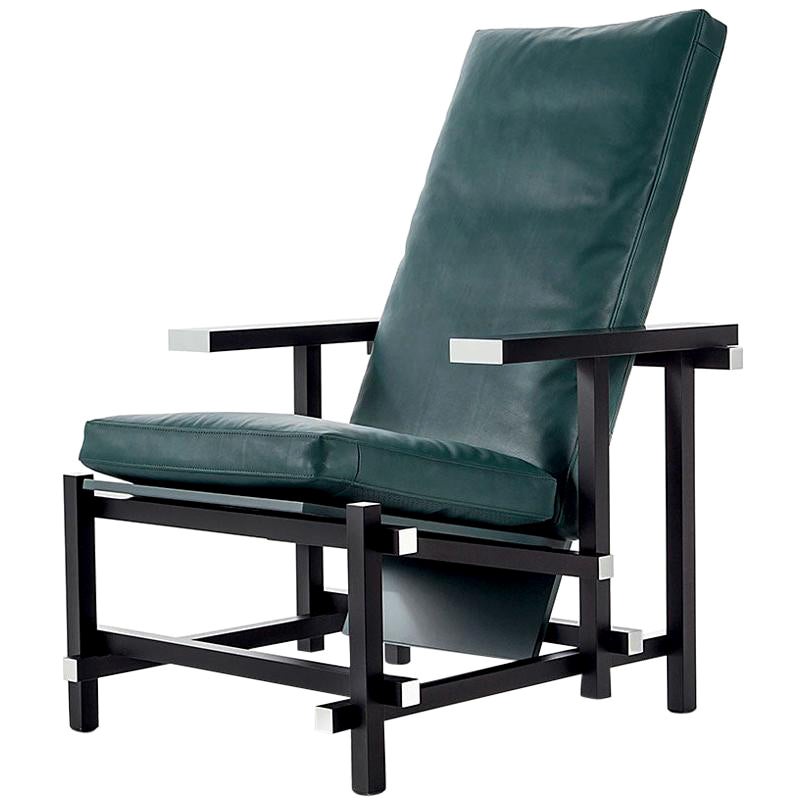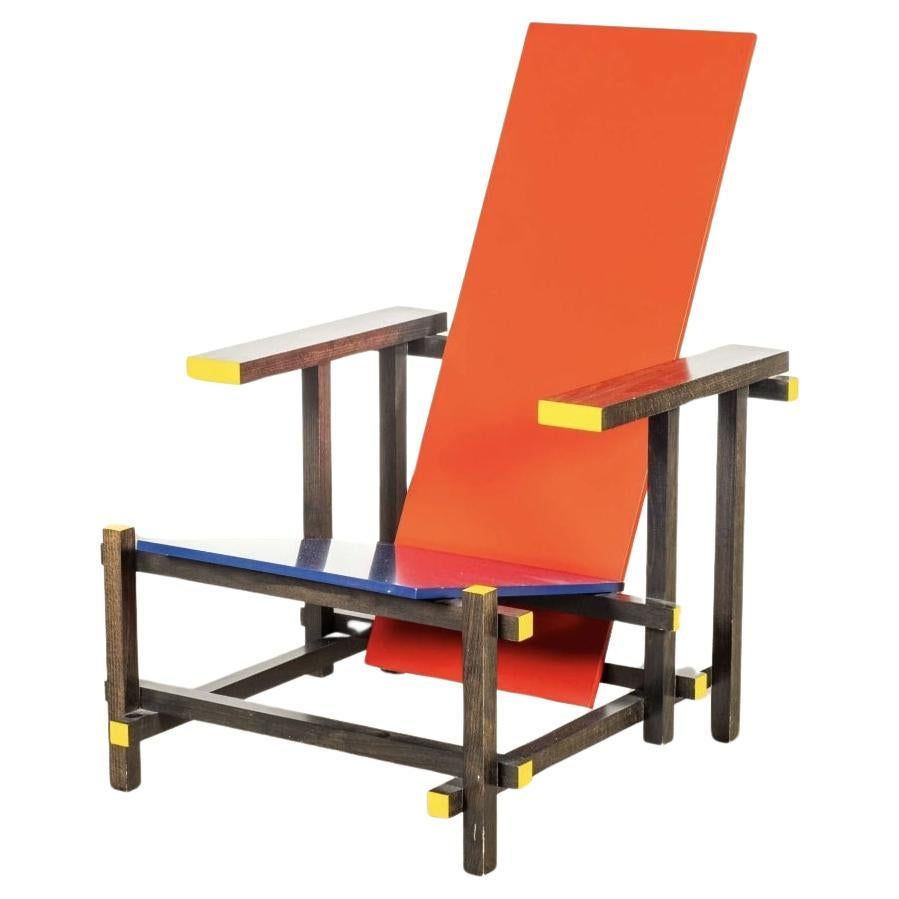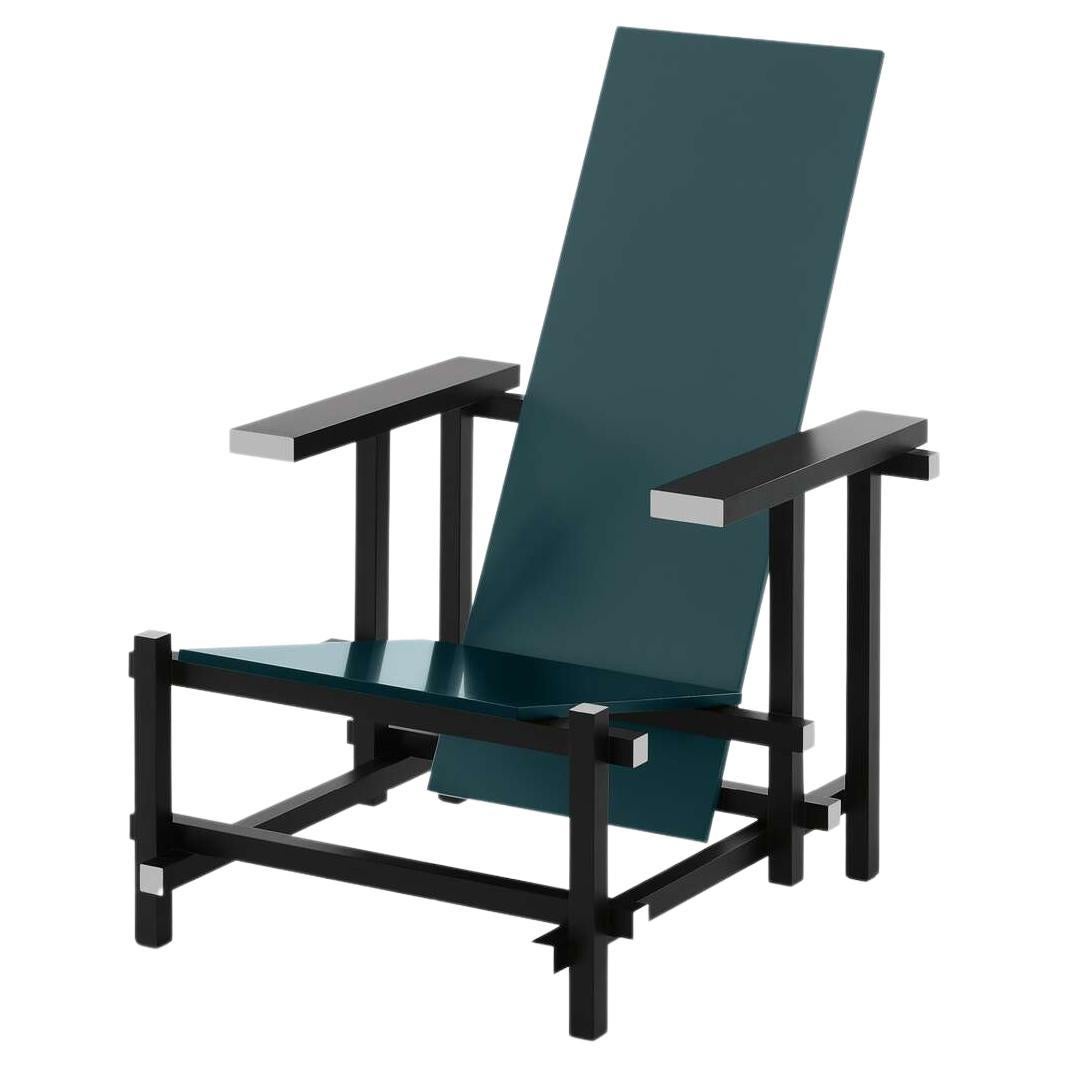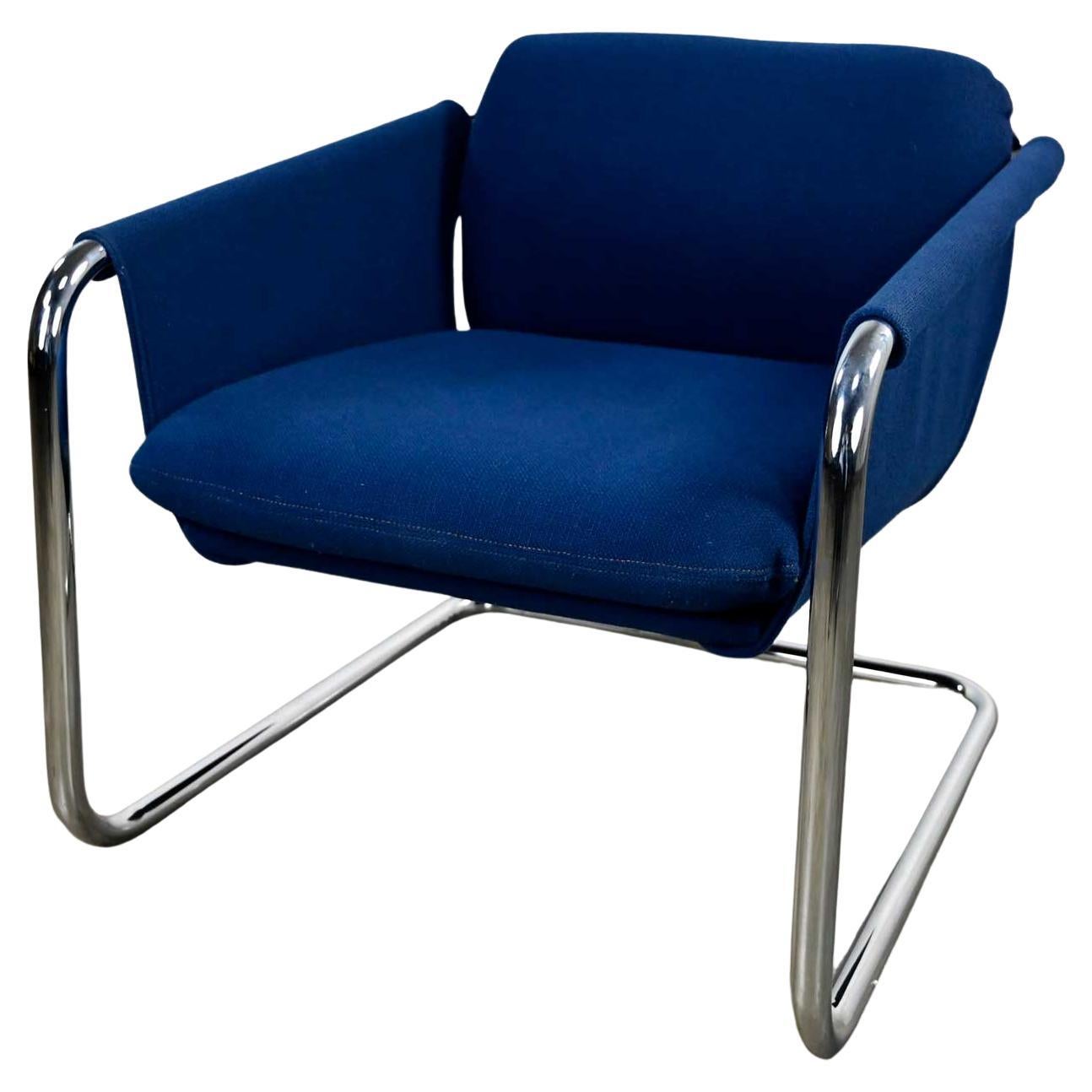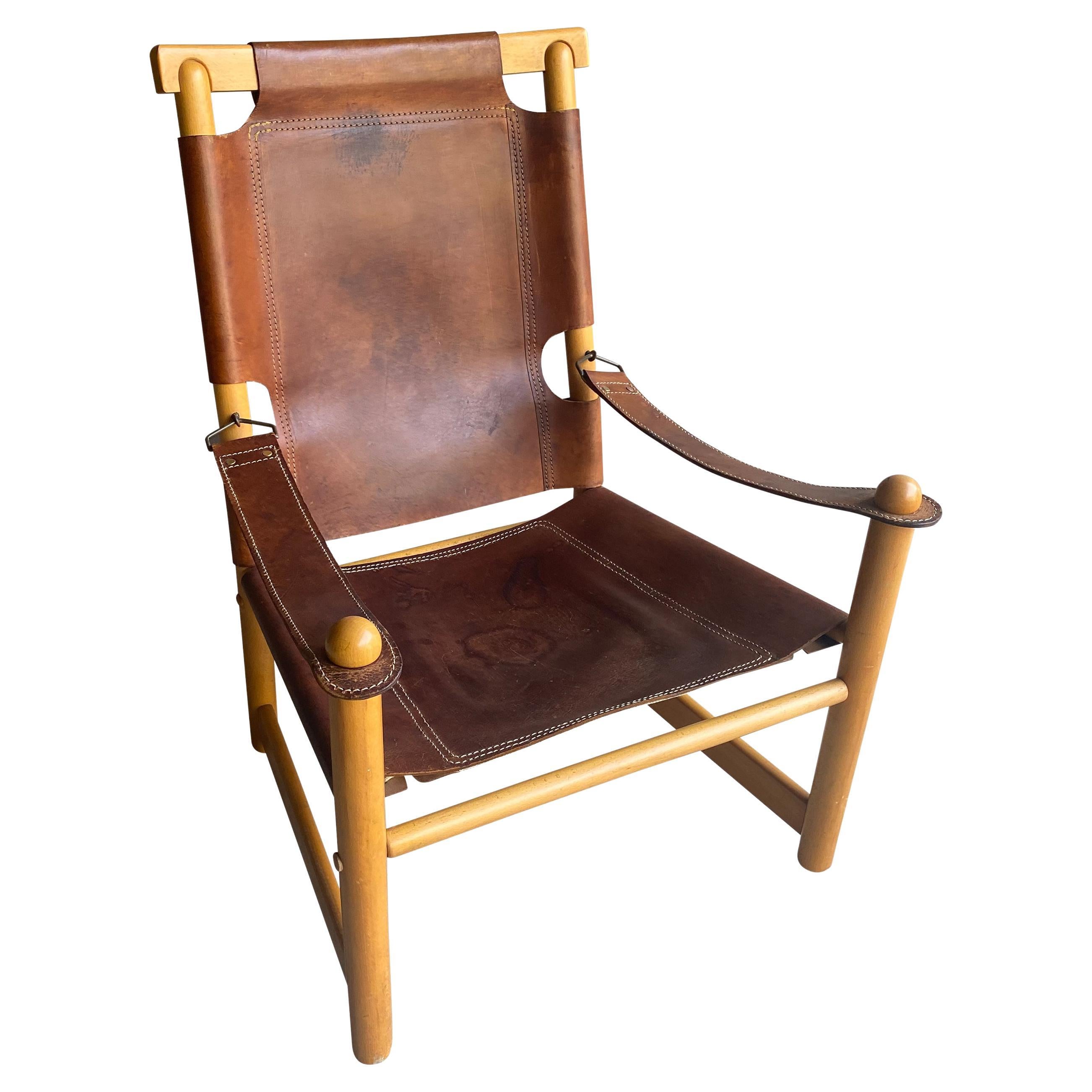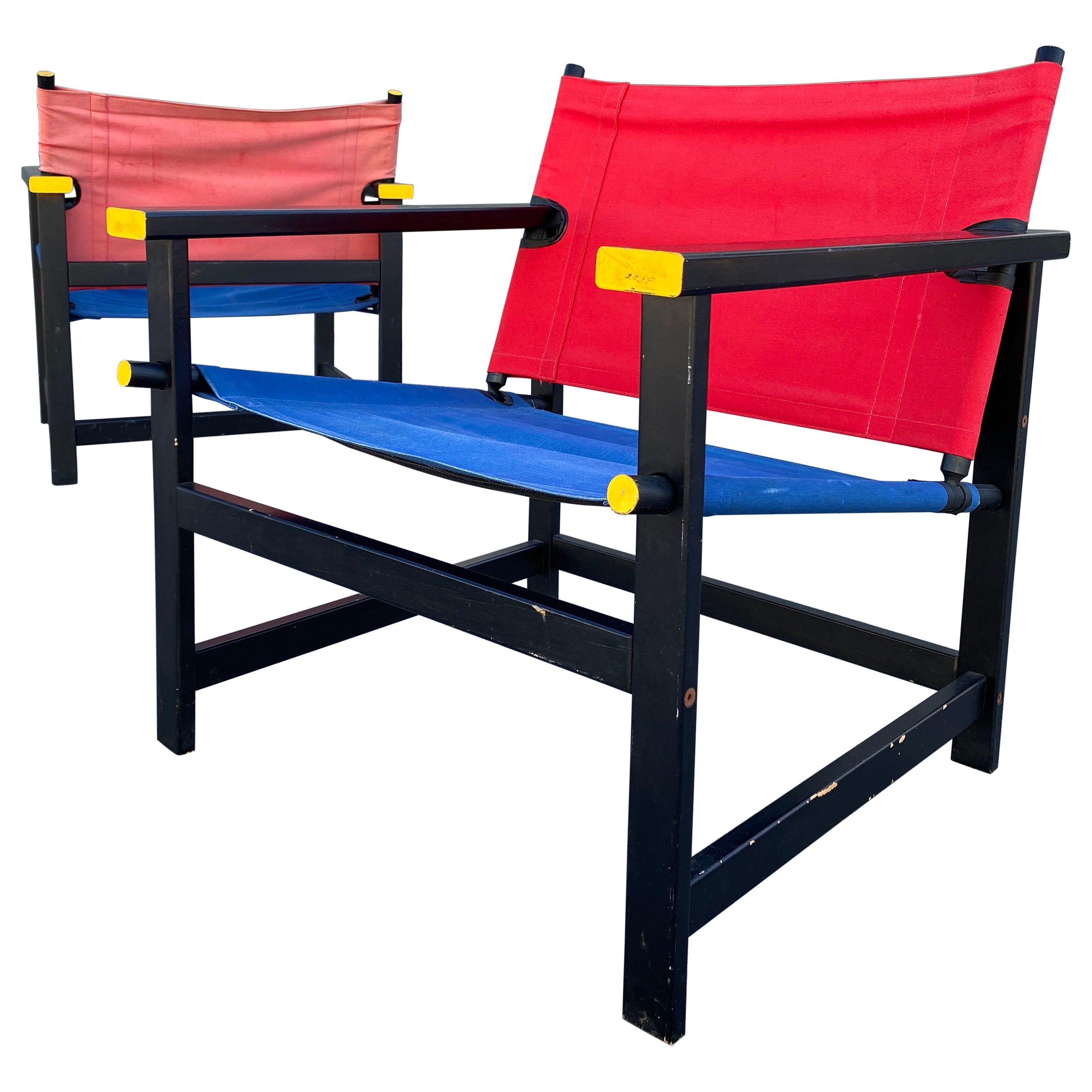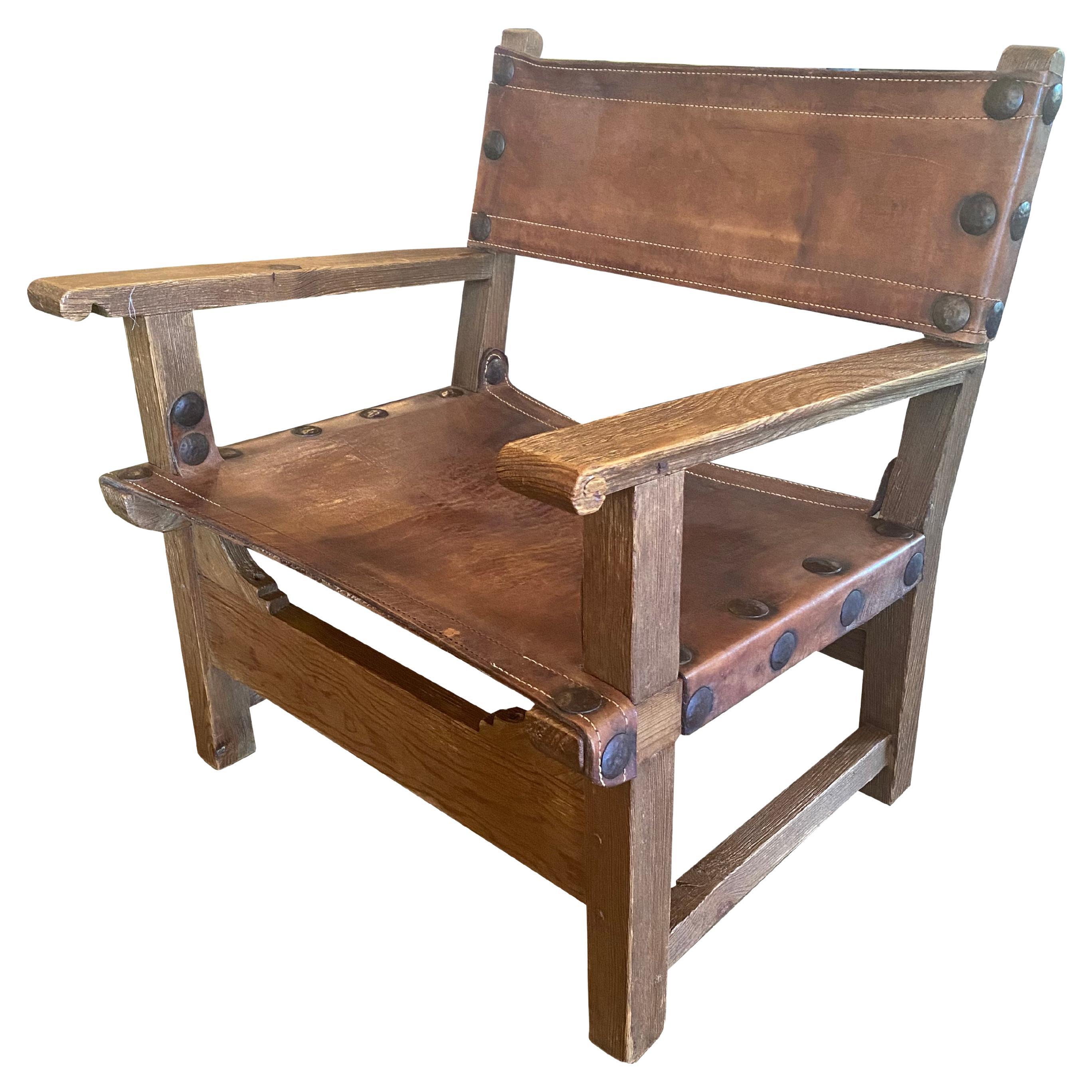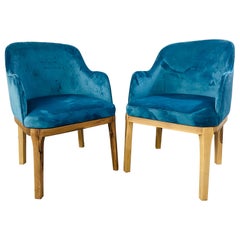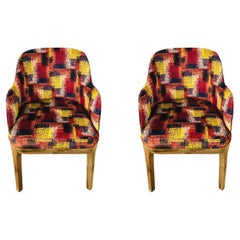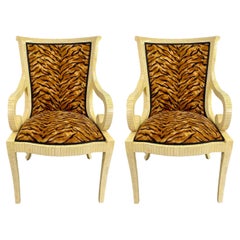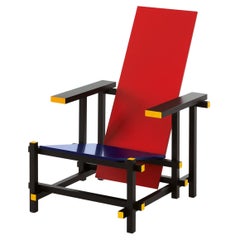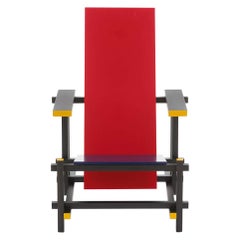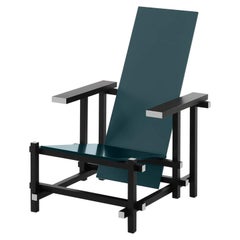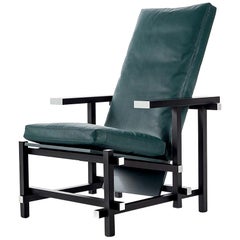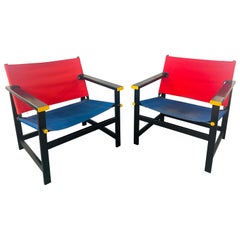
Mondrian Red and Blue Style Sling Chair, a Pair
View Similar Items
Want more images or videos?
Request additional images or videos from the seller
1 of 16
Mondrian Red and Blue Style Sling Chair, a Pair
About the Item
- Similar to:Gerrit Rietveld (Designer)
- Dimensions:Height: 25 in (63.5 cm)Width: 25 in (63.5 cm)Length: 25 in (63.5 cm)Seat Height: 13.5 in (34.29 cm)
- Sold As:Set of 2
- Style:De Stijl (In the Style Of)
- Materials and Techniques:
- Period:
- Date of Manufacture:1980s
- Condition:Wear consistent with age and use. Minor fading. Some fading to the seat textile blue color as shown on the picture.
- Seller Location:Plainview, NY
- Reference Number:Seller: AS-JW021stDibs: LU5060222664122
About the Seller
5.0
Platinum Seller
Premium sellers with a 4.7+ rating and 24-hour response times
Established in 2014
1stDibs seller since 2019
325 sales on 1stDibs
Authenticity Guarantee
In the unlikely event there’s an issue with an item’s authenticity, contact us within 1 year for a full refund. DetailsMoney-Back Guarantee
If your item is not as described, is damaged in transit, or does not arrive, contact us within 7 days for a full refund. Details24-Hour Cancellation
You have a 24-hour grace period in which to reconsider your purchase, with no questions asked.Vetted Professional Sellers
Our world-class sellers must adhere to strict standards for service and quality, maintaining the integrity of our listings.Price-Match Guarantee
If you find that a seller listed the same item for a lower price elsewhere, we’ll match it.Trusted Global Delivery
Our best-in-class carrier network provides specialized shipping options worldwide, including custom delivery.More From This Seller
View AllMid-Century Modern Style Blue Velvet & Walnut Frame Barrel Chair, a Pair
Located in Plainview, NY
A stylish pair of Mid Century Modern style barrel chairs. The chairs feature a recent upholstery in an electric vivid blue velvet. a highly desirable and fashionable color. The high quality chairs are made of walnut wood. The natural color of the walnut wood showing burl patterns adds to the chairs beauty and elegance. This pair of MCM style chairs...
Category
Late 20th Century European Mid-Century Modern Armchairs
Materials
Upholstery, Velvet, Walnut
$2,400 Sale Price
25% Off
Mid-Century Modern Style Chair Multicolor Upholstery and Walnut Frame, a Pair
Located in Plainview, NY
A stylish pair of Mid Century Modern style barrel chairs. The chairs feature a recent upholstery in vivid dark blue, yellow and cranberry colors. The high quality chairs are made of walnut wood. The natural color of the walnut wood showing burl patterns adds to the chairs beauty and elegance. This pair of MCM style chairs...
Category
1990s Mid-Century Modern Armchairs
Materials
Upholstery, Walnut
Enrique Garcel Off-White Bone Lounge Chair or Armchair, a Pair
By Enrique Garcel
Located in Plainview, NY
Pair of Enrique Garcel off-white bone style armchairs. Each tessellated form armchair with scrolling arm and body type. Both stylish and sleek showing off a nice leopard upholstery f...
Category
Late 20th Century Colombian Mid-Century Modern Armchairs
Materials
Bone, Fabric
$1,825 Sale Price / set
50% Off
Mid Century Boho Chic Faux Bamboo Rattan Chair
Located in Plainview, NY
A quality Mid Century Boho Chic faux bamboo and Rattan armchair. Finely carved , the chair features curved arms resting on a rattan seat. The back of the chair is slightly curved pro...
Category
Mid-20th Century Bohemian Armchairs
Materials
Faux Bamboo, Rattan
$570 Sale Price
40% Off
Eero Saarinen for Knoll MCM Tumeric Orange Uphostery Side Chair, a Pair
By Eero Saarinen
Located in Plainview, NY
The pair of Mid-Century Modern side chairs by Eero Saarinen for Knoll Associates encapsulates the essence of sleek, modernist elegance that defined the era. Upholstered in a vibrant ...
Category
Mid-20th Century American Mid-Century Modern Side Chairs
Materials
Metal
$1,440 Sale Price / set
20% Off
Folke Ohlsson for Fritz Hansen MCM Lounge Chair in Green Upholstery, a Pair
By Fritz Hansen, Folke Ohlsson
Located in Plainview, NY
A pair of Mid-Century Modern lounge or easy chairs designed by Folke Ohlsson (Sweden, 1919-2003) for Fritz Hansen ( established - Denmark 1872 by Cabinet Maker Fritz Hansen).
These conformable and fine lounge chairs model 0863 were crafted and designed in Denmark in 1957. Made of beach wood, the stylish chairs feature a green upholstery, clean lines and distinctly tapered legs. The wing-shaped armrests add comfort and elegance to the MCM chairs...
Category
Mid-20th Century Danish Mid-Century Modern Lounge Chairs
Materials
Upholstery, Beech
$6,900 Sale Price / set
40% Off
You May Also Like
Gerrit Rietveld Red and Blue Chair by Cassina
By Gerrit Rietveld, Cassina
Located in Barcelona, Barcelona
Chair designed by Gerrit Rietveld in 1918. Relaunched in 1973.
Manufactured by Cassina in Italy.
A sculptural seat with a pure and rationalist form, this chair became an authenti...
Category
2010s Italian Mid-Century Modern Armchairs
Materials
Wood
$6,750 / item
Gerrit Rietveld Red and Blue Chair for Cassina, Italy, new
By Gerrit Rietveld, Cassina
Located in Berlin, DE
Prices vary dependent on the chosen material/color. Chair designed by Gerrit Rietveld in 1918. Relaunched in 1973. Manufactured by Cassina in Italy.
Category
21st Century and Contemporary Italian Chairs
Materials
Wood
Gerrit Rietveld Zeilmaker Version of Black Red and Blue Chair by Cassina
By Cassina, Gerrit Rietveld
Located in Barcelona, Barcelona
Chair designed by Gerrit Rietveld in 1920. Relaunched in 2015.
Manufactured by Cassina in Italy.
One of the versions of the iconic model dated 1918. The structure is in black-stained beechwood with white contrasting parts. Seat and back in green lacquered multiplywood.
The black red and blue (Zeilmaker version) born from Rietveld’s chromatic experimentation
While researching the origins of the red and blue model in collaboration with the Rietveld heirs, it emerged that the key idea of the first prototypes was based on the concept of spatial organization expressed through the monochrome tones of its elements. The first version was in fact produced in 1918 in completely unpainted wood.
In the following years Rietveld proposed various examples, either monochrome or painted in different colors, depending on the requirements of his customers and the interiors for which the chairs were intended. As such, it comes as no surprise to find this 1920s version, presented as part of Cassina’s MutAzioni selection, created for the school teacher Wicher Zeilmaker with a black frame with white ends and a dark green painted seat and backrest.
It was Rietveld’s ever-increasing involvement in the De Stijl movement that led him to also use primary colors on this model in 1923, and as such the chair became a veritable manifesto for the emerging neoplastic movement. Initially dubbed slat chair, Rietveld only gave it the name red and blue in the 1950s following its chromatic evolution.
The various owners of the different examples used the chair as an abstract-realist sculpture in their interiors and, in some cases, as a simple tool for sitting on, adding cushions to make it more comfortable, just like Cassina offers for the black red and blue today.
Important information regarding images of products:
Please note that some of the images show other colors and variations of the model, these images are only to present interior design proposals. The item that is selling is on the first image.
Important information regarding color(s) of products:
Actual colors may vary. This is due to the fact that every computer monitor, laptop, tablet and phone screen has a different capability to display colors and that everyone sees these colors differently. We try to edit our photos to show all of our products as life-like as possible, but please understand the actual color may vary slightly from your monitor
About the designer:
Gerrit Thomas Rietveld, born in Utrecht on 24 June 1888, seems possessed of two personalities, each so distinct that one might take his work to be that of more than one artist. The first personality is that seen in the craftsman cabinet-maker working in a primordial idiom, re-inventing chairs and other furniture as if no one had ever built them before him and following a structural code all of his own; the second is that of the architect working with elegant formulas, determined to drive home the rationalist and neoplastic message in the context of European architecture. The two activities alternate, overlap, and fuse in a perfect osmosis unfolding then into a logical sequence. In 1918 Rietveld joined the “De Stijl” movement which had sprung up around the review of that name founded the year before by Theo van Doesburg. The group assimilated and translated into ideology certain laws on the dynamic breakdown of compositions (carrying them to an extreme) that had already been expressed in painting by the cubists: the “De Stijl” artists also carefully studied the architectonic lesson taught by the great Frank Lloyd Wright, whose influence was widely felt in Europe at that time.
Collaborating first with Robert van’t Hoff and Vilmos Huszar, then with Theo van Doesburg and Cornelius van Eesteren, Rietveld soon became one of the most distinguished interpreters of the neoplastic message.
Among his most important works are:
the Schröder house at Utrecht (1924); the “Row Houses” at Utrecht (1931-1934); the Dutch pavilion at the Venice Biennial (1954); the sculpture pavilion in the Rijksmuseum Kröller-Müller at Otterloo and the Van Gogh Museum in Amsterdam (1955). Out of his equally important furniture, Cassina has chosen for its own production: the “Red and Blue” (1918), the “Zig-Zag” (1934), the “Schröder 1...
Category
2010s Italian Mid-Century Modern Armchairs
Materials
Leather, Wood
Gerrit Rietveld Zeilmaker Version of Black Red and Blue Chair by Cassina
By Gerrit Rietveld, Cassina
Located in Barcelona, Barcelona
Chair designed by Gerrit Rietveld in 1920. Relaunched in 2015.
Manufactured by Cassina in Italy.
One of the versions of the iconic model dated 1918. The structure is in black-stained beechwood with white contrasting parts. Seat and back in green lacquered multiplywood. The armchair can have a single seat and backrest cushion in fabric or leather.
The black red and blue (Zeilmaker version) born from Rietveld’s chromatic experimentation
While researching the origins of the red and blue model in collaboration with the Rietveld heirs, it emerged that the key idea of the first prototypes was based on the concept of spatial organization expressed through the monochrome tones of its elements. The first version was in fact produced in 1918 in completely unpainted wood.
In the following years Rietveld proposed various examples, either monochrome or painted in different colors, depending on the requirements of his customers and the interiors for which the chairs were intended. As such, it comes as no surprise to find this 1920s version, presented as part of Cassina’s MutAzioni selection, created for the school teacher Wicher Zeilmaker with a black frame with white ends and a dark green painted seat and backrest.
It was Rietveld’s ever-increasing involvement in the De Stijl movement that led him to also use primary colors on this model in 1923, and as such the chair became a veritable manifesto for the emerging neoplastic movement. Initially dubbed slat chair, Rietveld only gave it the name red and blue in the 1950s following its chromatic evolution.
The various owners of the different examples used the chair as an abstract-realist sculpture in their interiors and, in some cases, as a simple tool for sitting on, adding cushions to make it more comfortable, just like Cassina offers for the black red and blue today.
Important information regarding images of products:
Please note that some of the images show other colors and variations of the model, these images are only to present interior design proposals. The item that is selling is on the first image.
Important information regarding color(s) of products:
Actual colors may vary. This is due to the fact that every computer monitor, laptop, tablet and phone screen has a different capability to display colors and that everyone sees these colors differently. We try to edit our photos to show all of our products as life-like as possible, but please understand the actual color may vary slightly from your monitor
About the designer:
Gerrit Thomas Rietveld, born in Utrecht on 24 June 1888, seems possessed of two personalities, each so distinct that one might take his work to be that of more than one artist. The first personality is that seen in the craftsman cabinet-maker working in a primordial idiom, re-inventing chairs and other furniture as if no one had ever built them before him and following a structural code all of his own; the second is that of the architect working with elegant formulas, determined to drive home the rationalist and neoplastic message in the context of European architecture. The two activities alternate, overlap, and fuse in a perfect osmosis unfolding then into a logical sequence. In 1918 Rietveld joined the “De Stijl” movement which had sprung up around the review of that name founded the year before by Theo van Doesburg. The group assimilated and translated into ideology certain laws on the dynamic breakdown of compositions (carrying them to an extreme) that had already been expressed in painting by the cubists: the “De Stijl” artists also carefully studied the architectonic lesson taught by the great Frank Lloyd Wright, whose influence was widely felt in Europe at that time.
Collaborating first with Robert van’t Hoff and Vilmos Huszar...
Category
2010s Italian Mid-Century Modern Armchairs
Materials
Leather, Wood
Gerrit Rietveld Zeilmaker Version of Black Red and Blue Chair by Cassina
By Gerrit Rietveld, Cassina
Located in Barcelona, Barcelona
Chair designed by Gerrit Rietveld in 1920. Relaunched in 2015.
Manufactured by Cassina in Italy.
One of the versions of the iconic model dated 1918. The structure is in black-stained beechwood with white contrasting parts. Seat and back in green lacquered multiplywood.
The black red and blue (Zeilmaker version) born from Rietveld’s chromatic experimentation
While researching the origins of the red and blue model in collaboration with the Rietveld heirs, it emerged that the key idea of the first prototypes was based on the concept of spatial organization expressed through the monochrome tones of its elements. The first version was in fact produced in 1918 in completely unpainted wood.
In the following years Rietveld proposed various examples, either monochrome or painted in different colors, depending on the requirements of his customers and the interiors for which the chairs were intended. As such, it comes as no surprise to find this 1920s version, presented as part of Cassina’s MutAzioni selection, created for the school teacher Wicher Zeilmaker with a black frame with white ends and a dark green painted seat and backrest.
It was Rietveld’s ever-increasing involvement in the De Stijl movement that led him to also use primary colors on this model in 1923, and as such the chair became a veritable manifesto for the emerging neoplastic movement. Initially dubbed slat chair, Rietveld only gave it the name red and blue in the 1950s following its chromatic evolution.
The various owners of the different examples used the chair as an abstract-realist sculpture in their interiors and, in some cases, as a simple tool for sitting on, adding cushions to make it more comfortable, just like Cassina offers for the black red and blue today.
Important information regarding images of products:
Please note that some of the images show other colors and variations of the model, these images are only to present interior design proposals. The item that is selling is on the first image.
Important information regarding color(s) of products:
Actual colors may vary. This is due to the fact that every computer monitor, laptop, tablet and phone screen has a different capability to display colors and that everyone sees these colors differently. We try to edit our photos to show all of our products as life-like as possible, but please understand the actual color may vary slightly from your monitor
About the designer:
Gerrit Thomas Rietveld, born in Utrecht on 24 June 1888, seems possessed of two personalities, each so distinct that one might take his work to be that of more than one artist. The first personality is that seen in the craftsman cabinet...
Category
2010s Italian Mid-Century Modern Armchairs
Materials
Leather, Wood
Gerrit Rietveld Zeilmaker Version of Black Red and Blue Chair by Cassina
By Gerrit Rietveld, Cassina
Located in Barcelona, Barcelona
Chair designed by Gerrit Rietveld in 1920. Relaunched in 2015.
Manufactured by Cassina in Italy.
One of the versions of the iconic model dated 1918. The structure is in black-stained beechwood with white contrasting parts. Seat and back in green lacquered multiplywood. The armchair can have a single seat and backrest cushion in fabric or leather.
The black red and blue (Zeilmaker version) born from Rietveld’s chromatic experimentation
While researching the origins of the red and blue model in collaboration with the Rietveld heirs, it emerged that the key idea of the first prototypes was based on the concept of spatial organization expressed through the monochrome tones of its elements. The first version was in fact produced in 1918 in completely unpainted wood.
In the following years Rietveld proposed various examples, either monochrome or painted in different colors, depending on the requirements of his customers and the interiors for which the chairs were intended. As such, it comes as no surprise to find this 1920s version, presented as part of Cassina’s MutAzioni selection, created for the school teacher Wicher Zeilmaker with a black frame with white ends and a dark green painted seat and backrest.
It was Rietveld’s ever-increasing involvement in the De Stijl movement that led him to also use primary colors on this model in 1923, and as such the chair became a veritable manifesto for the emerging neoplastic movement. Initially dubbed slat chair, Rietveld only gave it the name red and blue in the 1950s following its chromatic evolution.
The various owners of the different examples used the chair as an abstract-realist sculpture in their interiors and, in some cases, as a simple tool for sitting on, adding cushions to make it more comfortable, just like Cassina offers for the black red and blue today.
Production delay:
8-9 weeks
Important information regarding images of products:
Please note that some of the images show other colors and variations of the model, these images are only to present interior design proposals. The item that is selling is on the first image.
Important information regarding color(s) of products:
Actual colors may vary. This is due to the fact that every computer monitor, laptop, tablet and phone screen has a different capability to display colors and that everyone sees these colors differently. We try to edit our photos to show all of our products as life-like as possible, but please understand the actual color may vary slightly from your monitor
About the designer:
Gerrit Thomas Rietveld, born in Utrecht on 24 June 1888, seems possessed of two personalities, each so distinct that one might take his work to be that of more than one artist. The first personality is that seen in the craftsman cabinet-maker working in a primordial idiom, re-inventing chairs and other furniture as if no one had ever built them before him and following a structural code all of his own; the second is that of the architect working with elegant formulas, determined to drive home the rationalist and neoplastic message in the context of European architecture. The two activities alternate, overlap, and fuse in a perfect osmosis unfolding then into a logical sequence. In 1918 Rietveld joined the “De Stijl” movement which had sprung up around the review of that name founded the year before by Theo van Doesburg. The group assimilated and translated into ideology certain laws on the dynamic breakdown of compositions (carrying them to an extreme) that had already been expressed in painting by the cubists: the “De Stijl” artists also carefully studied the architectonic lesson taught by the great Frank Lloyd Wright, whose influence was widely felt in Europe at that time.
Collaborating first with Robert van’t Hoff and Vilmos Huszar, then with Theo van Doesburg and Cornelius van Eesteren, Rietveld soon became one of the most distinguished interpreters of the neoplastic message.
Among his most important works are:
the Schröder house at Utrecht (1924); the “Row Houses” at Utrecht (1931-1934); the Dutch pavilion at the Venice Biennial (1954); the sculpture pavilion in the Rijksmuseum Kröller-Müller at Otterloo and the Van Gogh Museum in Amsterdam (1955). Out of his equally important furniture, Cassina has chosen for its own production: the “Red and Blue” (1918), the “Zig-Zag” (1934), the “Schröder 1...
Category
2010s Italian Mid-Century Modern Armchairs
Materials
Leather, Wood
Recently Viewed
View AllMore Ways To Browse
Berte Jessen On Sale
Bertil Fridhagen Aristokrat
Bertil Vallien Rorstrand
Bertoia Candelabra
Betsy Patterson
Bicycle Bar Cart
Biedermeier Globe
Biedermeier Tea Cup
Billy Wilder Eames
Bimini Martini Glasses
Birger Hahl
Birks Sterling Saxon
Bishop Stool
Bissy Riva
Bitossi Ram
Bjorn Wiinblad Pitcher
Black African Benches
Black And Gold Caned Side Table
